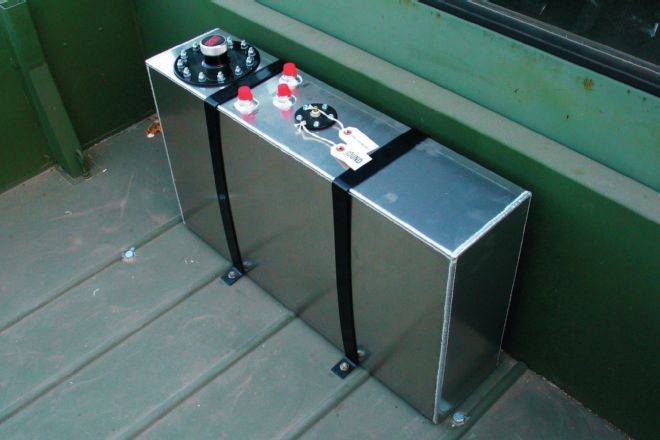
 John Cappa
Former Editor, Four Wheeler
John Cappa
Former Editor, Four Wheeler
Chrysler or Ford Axle
Q I saw a quick mention on fourwheeler.com about a Chrysler 8.25 rear axle from a 1999 Cherokee Editor-In-Chief Hazel put into a YJ Wrangler. If you had access to a free Chrysler 8.25 with 4.10s and a 29-spline shafts, would you do the swap again or would you hold out for a Ford 8.8-inch?
Eric Faley
Via email
Editor-In-Chief Christian Hazel responds:
A If all you need is 4.10s (at the time, 4.56s were as deep as you could get for the 8.25 but now 4.88s are available), then I’d for sure go with the XJ axle. It doesn’t have disc brakes like some of the Ford 8.8s, but the Ford 8.8 isn’t as wide as the Jeep axle so you need to run wheel spacers to match the track width of the Dana 30 front. Plus, you have to do some modifications to the rear driveshaft to get it to hook up to the Ford 8.8 yoke flange.
The 8.25 is the same width as the Dana 35 in your Wrangler. The existing driveshaft will work unless you have one of the not-too-common YJs that used a 1330 U-joint at the axle yoke. In that case, you can get a Spicer 1330-to-1310 conversion joint from Tom Wood’s Custom Drive Shafts (4xshaft.com) to hook up to the 8.25’s 1310 yoke. Also, you’ll need to retain the 8.25 parking brake cables since the Dana 35 cables won’t work with the 8.25’s backing plate or E-brake hardware. The 8.25 cables will hook right to the E-brake cable on the Wrangler’s frame. Just weld on your spring perches in the correct location (or control arm brackets if it’s a TJ), hook up the brake lines, bleed the brake system, and you’re good to go.
Fuel Cell Sense
Q My giant 32-gallon Jaz fuel cell is super dirty and keeps clogging up my Quadrajet carburetor on my 1971 GMC.
I think the easiest and simplest way to fix it is by ditching that fuel cell and swapping in a new one. The original plan was to install what I thought was a Blazer gas tank, but it turns out the tank I had is from a Suburban and is 40 gallons. I was pretty excited, and then I slid it underneath and realized there were two crossmembers in the way, and even if I knock them out of the way, the custom rear tube bumper will still be in the way.
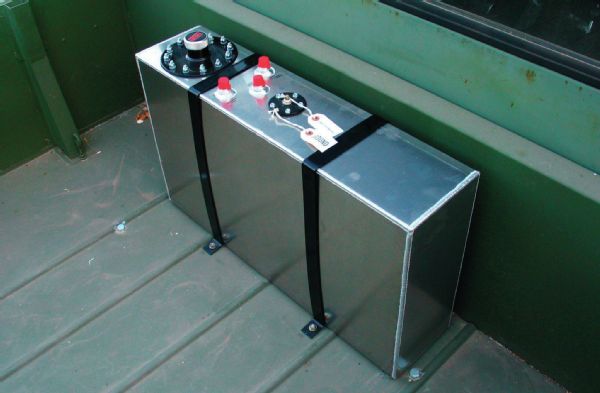
So now my options are to upgrade to a new fuel cell so I wanted to get your opinion on how you like the aluminum fuel cell in that CUCV (“GI Gyp,” Dec. 2013). Is 17 gallons enough fuel to get around? I really don’t drive the GMC all that often, and honestly, if it can go 150 miles, I can live with stopping for fuel during trips.
How many gallons do you think is sufficient, and what would you recommend I go with?
Agustin Jimenez
Via email
A Replacing the fuel cell because it has dirt in it seems excessive. Does the fuel cell still have the anti-slosh foam in it? If so, drain the tank, remove the filler neck, yank the foam out, and throw it away. Over time, the foam deteriorates and makes its way into the fuel system. In most cases, a fuel filter will stop the foam bits from reaching the carburetor. However, the filter will eventually become clogged so it’s best to remove the foam in non-race applications that don’t require it.
Once you have the foam removed, replace the fuel filters. You should put one before the fuel pump and one after the fuel pump. This will guarantee that you capture any loose particles in the fuel. Also, make sure that your fuel line is an actual fuel line. Rubber hose that is not rated for fuel will deteriorate from the inside-out and clog your carb.
You should also rinse or wipe out the bottom of the tank and make sure it’s clean before reinstalling it in the truck. You can siphon the fuel out into gas cans and use an inline filter to pull the debris out of the fuel.
Looking back, I sort of wish I had at least 22 gallons in my truck. As with most modified fullsize trucks, even though mine is a diesel, it still gets about 10 mpg thanks to the 3.73 axle gearing and 40-inch tires (I’ll remedy that soon). However, the tall and narrow shape of this tank lends itself to off-roading more than some of the other fuel cell options. The fuel pickup remains submerged in most off-road situations. I also wanted to still be able to use the bed of the truck and not have it filled with a fuel cell. In the future, I may add a second 17-gallon RCI fuel cell from Summit Racing (summitracing.com) and simply move the existing one over so they sit end to end. That way I only lose about 8 inches of bed space but get a total of 34 gallons of fuel.
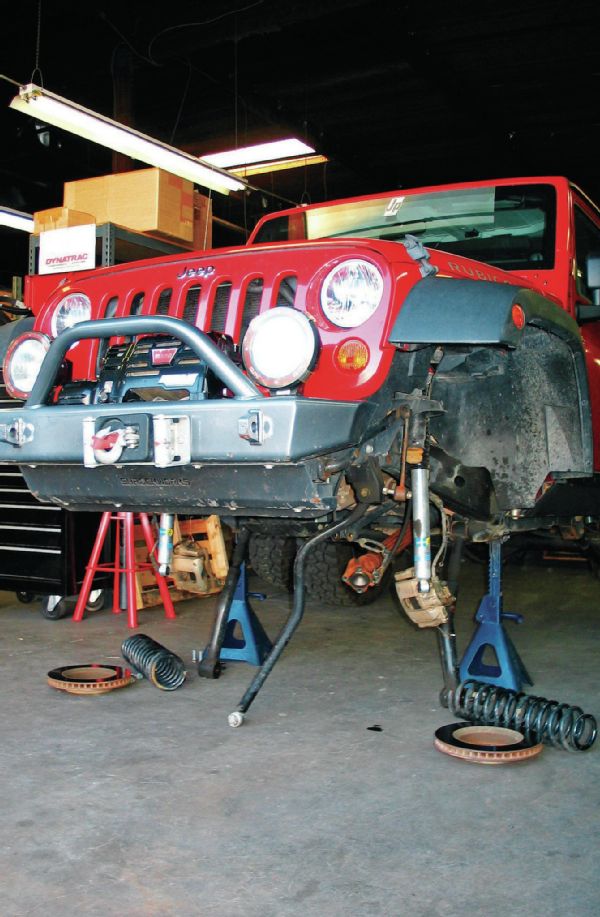
JK to YJ Axle Swap
Q I bought a 1991 YJ new and have been tackling the Rubicon for nearly 20 years. Now it is time to put a little Rubicon back in to it. The stock axles and 33-inch tires just aren’t sufficient anymore. The stock Dana 30 is tired. I have a set of 2012 Rubicon axles and stock 17-inch wheels with 35-inch tires that I want to install while maintaining my simple 4.5-inch Rubicon Express spring-under suspension. I drive this rig on highways frequently. It takes me three hours to get to Georgetown, California.
I am finding solutions for the various challenges except for one. I have read that the tie rod will not clear the leaf springs in its existing location, and with a spring-over suspension the drag link will not clear the springs. An article in your sister mag covered a similar install with a spring-over suspension, but provides what appears to be a very custom solution with not enough detail for this reader. The drag link appears set up 2 inches higher. How did they do that with such high leverage pressing on it? The project uses rod ends, offset ball joints, and aluminum stock.
If I try to flip the tie rod to maintain a spring-under suspension, I get interference with the drag link. Maybe a high-steer solution would also be needed? I was hoping for a simple, low-buck solution. Do I need to consider a spring-over as an easier route with high-steer knuckles? I’d rather stay spring-under. I would like to maintain as many stock parts as feasible for cost and simplicity considerations.
Any bits of wisdom are greatly appreciated on the other axle challenges as well, including locker wiring, brake line adaptation, and so on. I have already sleeved the tube and reinforced the end forgings.
Chris Hornbeck
Orinda, CA
A Making an axle fit where it was never designed to go often requires a lot of head scratching and backyard ingenuity. I can imagine the JK steering components getting in the way in your application. You do have a couple of options, though. Would the steering linkage clear the spring-under suspension if you relocate both the drag link and tie rod to the topside of the steering arms? This can be done with Synergy MFG (synergymfg.com) TRE Adapters. The other option is to replace your stock steering knuckles with Reid Racing knuckles (reidracing.biz). These knuckles move the tie rod upward 1.5 inches and the drag link up 3 inches. You would likely need to remove your drop pitman arm (if your Jeep has one) and reinstall a stock pitman arm to make this work. You’ll need to take some measurements to see if either of these are viable options. The third, and likely less desirable solution, is to simply build a custom steering setup using more compact rod ends and spacers to clear the leaf springs.
Before and After
Q I’ve been a digital subscriber since buying my first (and only) Jeep. I bought a 1995 YJ in July 2011 for $3,200. I’ve dumped much more into it since the original purchase. The Jeep had 167,000 miles on it when I bought it and I’ve put 6,000 on it since. As a career soldier, deployments delayed the building and driving of the Jeep. Aside from the transmission rebuild, I’ve done all the work on it myself, including painting it in my driveway with three coats of black epoxy primer. I call it the Sheepdog because as a soldier for over 30 years, I’ve spent a majority of my life protecting the flock.
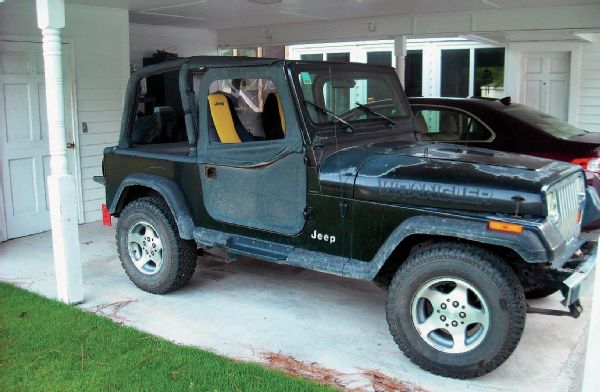 Before
Before
From a visual inspection, the Jeep has the factory-installed axles, and last fall I installed a Rough Country 4-inch lift with wedges. I assume they are intended to work with the transfer case drop, rather than a slip-yoke eliminator and CV driveshaft. As you can see in the after photo, I used the spacers to lower the transfer case. At this point I have a few questions about where to go from here: First, should I ditch the transfer-case spacers and go with a slip-yoke eliminator and a CV driveshaft? Next, I’ve read numerous online forums about removing the rear track bar after lifting the YJ. I’d like your thoughts or advice on keeping or removing the rear track bar. Also, and I know this may sound like anti-Jeep culture, but is there an air conditioning setup that I can scrounge from other Jeep models in a salvage yard that I can retro-fit into my YJ? I generally run with the top down in summer here in West Point, New York, but sometimes a bit of nice, cool air would be welcome. And finally, any other recommendations to enhance the YJ would be appreciated.
My grandson is two-years-old. Many years from now I plan on handing him the keys to the YJ, after I enjoy it for a while of course.
Rob Duane
Cmd Sgt Major, US Corps of Cadets
West Point, NY
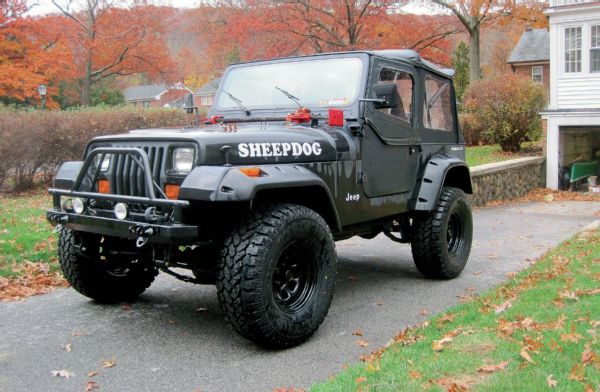 After
After
Editor-In-Chief Christian Hazel responds:
A Thanks for your service, Rob.
Change the oil regularly and that 4.0L should give you another 100,000 miles.
I’m more off-road oriented than most, so I’d ditch the front and rear track bars as well as the sway bar. It’s all nanny-state apparatus foisted on Jeep in the mid-’80s by the federal government. The rear definitely isn’t needed. If you pull the front, depending on your pitman arm drop you may get bumpsteer, in which case you can just put it back on.
As for the T-case, it will definitely be an improvement ditching the crossmember drop and adding a slip-yoke eliminator and CV driveshaft. Don’t forget you’ll need to add steel degree wedges to the rear spring packs to rotate the pinion up for the CV shaft. Rubicon Express (rubiconexpress.com) makes nice solid-steel shims in 4-, 6-, or 8-degree sizes.
Add the A/C, brother! Collins Bros. Jeep (collinsbrosjeep.com) and Jeep Air (jeepair.com) both offer retrofit kits for YJ Wranglers.
Where To Write
Have a 4x4 tech question you want answered in Techline? Drop an email to fourwheelereditor@sorc.com or head on over to our forums at fourwheeler.com. All letters become the property of Four Wheeler, and we reserve the right to edit them for length, accuracy, and clarity. Due to the volume of mail, electronic and otherwise, we cannot respond to every reader, but we do read everything.